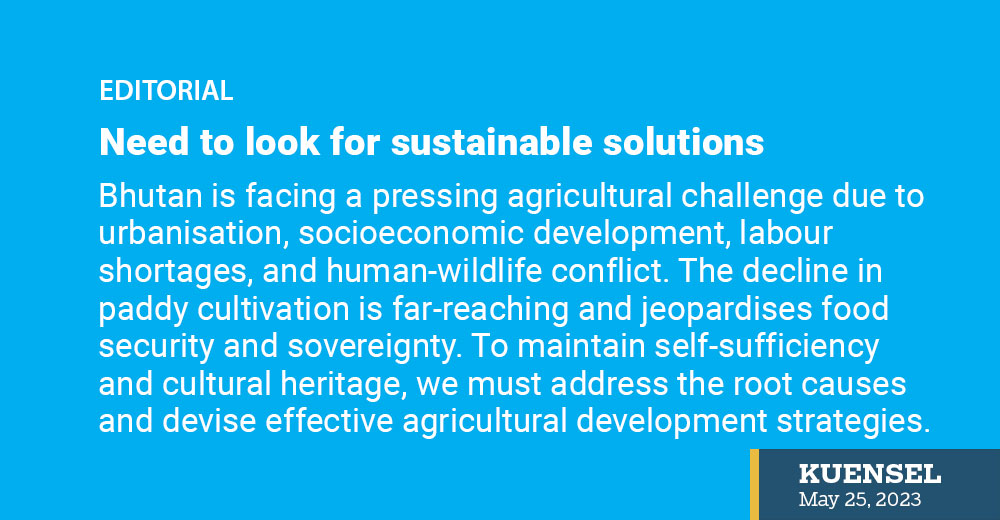Bhutan, a country known for its breathtaking natural beauty and lush agricultural landscapes, is facing a pressing agricultural challenge. Urbanisation, socioeconomic development, labour shortages, and human-wildlife conflict have all contributed to a worrying drop in paddy cultivation. The total area under paddy cultivation in 2022 came down to 40,106.81 acres, down from 40,804.95 acres in 2020. These figures demand our immediate attention, as well as a concerted effort to finding long-term solutions.
The consequences of the decline in paddy cultivation are far-reaching and extend beyond the agricultural sector. Bhutan, like many other countries, is under increasing pressure from rising import figures, which jeopardises our food security and, ultimately, our sovereignty. To maintain our self-sufficiency and cultural heritage, we must address the root causes of this downward trend and devise effective agricultural development strategies.
Urbanisation is a major factor contributing to the decline in paddy cultivation. We know this. As our country grows and develops rapidly, the conversion of prime paddy lands for urban expansion has resulted in a loss of cultivable land. While development is necessary for progress, we must strike a balance between urban expansion and the preservation of our agricultural heritage.
The decline in paddy cultivation is also because of socioeconomic development. Bhutan’s agricultural holders are increasingly turning to more economically viable crops that require less labour and resources as the country’s economy evolves. This shift in focus is understandable from an economic standpoint, but we must be careful not to jeopardise the long-term viability of our agricultural sector.
Furthermore, labour shortages pose a significant barrier to paddy cultivation. With an increasing number of young Bhutanese pursuing alternative livelihoods, skilled labour in the agricultural sector is in short supply. To address this issue, we must invest in novel approaches that make agriculture an appealing and rewarding career for the next generation. This could include implementing training programmes, providing financial incentives, and developing supportive policies in order to rekindle interest in farming.
Human-wildlife conflict complicates our agricultural challenges even more. Animals are increasingly encroaching on farmlands as our wildlife habitats shrink due to development, causing crop damage and loss. It is critical that we find a happy medium between conservation efforts and needs of agricultural community. Implementing effective wildlife management strategies, such as improved fencing, early warning systems, and farmer compensation mechanisms, can help to mitigate this conflict.
To overcome these obstacles, we must take a comprehensive and long-term approach to agricultural development. This includes investing in research and innovation to identify resilient crop varieties, improving irrigation systems, promoting organic-farming practices, and improving farmers’ access to markets. Furthermore, encouraging public-private partnerships and empowering local communities will foster a sense of ownership and stimulate agricultural entrepreneurship.
The agricultural sector in Bhutan is not only an economic pillar but also an important part of our cultural heritage and national identity. As we face an urgent need for practical solutions, it is critical that we prioritise agricultural development that is sustainable. We can ensure food security, protect our sovereignty, and preserve our unique agrarian way of life for future generations by addressing the factors that contribute to the decline in paddy cultivation and embracing innovative approaches.
The time to act is now because a resilient and thriving agricultural sector is critical to our nation’s well-being.


